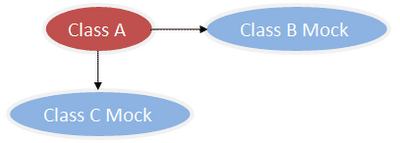
本文共 3721 字,大约阅读时间需要 12 分钟。
一、什么是mock测试,什么是mock对象?
先来看看下面这个示例:

从上图可以看出如果我们要对A进行测试,那么就要先把整个依赖树构建出来,也就是BCDE的实例。
一种替代方案就是使用mocks

从图中可以清晰的看出
mock对象就是在调试期间用来作为真实对象的替代品。
mock测试就是在测试过程中,对那些不容易构建的对象用一个虚拟对象来代替测试的方法就叫mock测试。
知道什么是mock测试后,那么我们就来认识一下mock框架---Mockito
二、什么是Mockito
除了有一个好记的名字外,Mockito尝试用不一样的方法做mocking测试,是简单轻量级能够替代EasyMock的框架。
使用简单,测试代码可读性高,丰富的文档包含在javadoc中,直接在IDE中可查看文档,实例,说明。
更多信息:
相同点:Stub和Mock对象都是用来模拟外部依赖,使我们能控制。
不同点:而stub完全是模拟一个外部依赖,用来提供测试时所需要的测试数据。
而mock对象用来判断测试是否能通过,也就是用来验证测试中依赖对象间的交互能否达到预期。
在mocking框架中mock对象可以同时作为stub和mock对象使用,两者并没有严格区别。 更多信息:
四、mockito入门实例
Maven依赖:(没用maven管理的可以下载相关jar包导入classpath)
Java代码org.mockito mockito-all 1.8.5 test
import static org.mockito.Mockito.*; import java.util.List; import org.junit.Assert; import org.junit.Test; /** * * @author lzjun * @version 0.1 * @date 2012-5-5 * {@link http://weibo.com/u/1697702241} * */ public class SimpleTest { @Test public void simpleTest(){ //创建mock对象,参数可以是类,也可以是接口 List list = mock(List.class); //设置方法的预期返回值 when(list.get(0)).thenReturn("helloworld"); String result = list.get(0); //验证方法调用(是否调用了get(0)) verify(list).get(0); //junit测试 Assert.assertEquals("helloworld", result); } } 好了,五分钟差不多了,还想继续了解那就可以往下面看![]()
创建mock对象不能对final,Anonymous ,primitive类进行mock。
可对方法设定返回异常
Java代码
when(list.get(1)).thenThrow(new RuntimeException("test excpetion")); stubbing另一种语法(设置预期值的方法),可读性不如前者
doReturn("secondhello").when(list).get(1); 没有返回值的void方法与其设定(支持迭代风格,第一次调用donothing,第二次dothrow抛出runtime异常)
doNothing().doThrow(new RuntimeException("void exception")).when(list).clear(); list.clear(); list.clear(); verify(list,times(2)).clear(); 五、参数匹配器(Argument Matcher)
Matchers类内加你有很多参数匹配器 anyInt、anyString、anyMap.....Mockito类继承于Matchers,Stubbing时使用内建参数匹配器,下例:
@Test public void argumentMatcherTest(){ List list = mock(List.class); when(list.get(anyInt())).thenReturn("hello","world"); String result = list.get(0)+list.get(1); verify(list,times(2)).get(anyInt()); Assert.assertEquals("helloworld", result); } 需要注意的是:如果使用参数匹配器,那么所有的参数都要使用参数匹配器,不管是stubbing还是verify的时候都一样。 @Test public void argumentMatcherTest2(){ Map map = mock(Map.class); when(map.put(anyInt(),anyString())).thenReturn("hello");//anyString()替换成"hello"就会报错 map.put(1, "world"); verify(map).put(eq(1), eq("world")); //eq("world")替换成"world"也会报错 } 六、方法调用的验证(具体的调用次数、至少一次,一次也没有)
@Test public void verifyInvocate(){ List mockedList = mock(List.class); //using mock mockedList.add("once"); mockedList.add("twice"); mockedList.add("twice"); mockedList.add("three times"); mockedList.add("three times"); mockedList.add("three times"); /** * 基本的验证方法 * verify方法验证mock对象是否有没有调用mockedList.add("once")方法 * 不关心其是否有返回值,如果没有调用测试失败。 */ verify(mockedList).add("once"); verify(mockedList, times(1)).add("once");//默认调用一次,times(1)可以省略 verify(mockedList, times(2)).add("twice"); verify(mockedList, times(3)).add("three times"); //never()等同于time(0),一次也没有调用 verify(mockedList, times(0)).add("never happened"); //atLeastOnece/atLeast()/atMost() verify(mockedList, atLeastOnce()).add("three times"); verify(mockedList, atLeast(2)).add("twice"); verify(mockedList, atMost(5)).add("three times"); } 一次写不完,慢慢分析。。。
参考:
转载地址:https://blog.csdn.net/xxxcyzyy/article/details/51045971 如侵犯您的版权,请留言回复原文章的地址,我们会给您删除此文章,给您带来不便请您谅解!
发表评论
最新留言
关于作者
